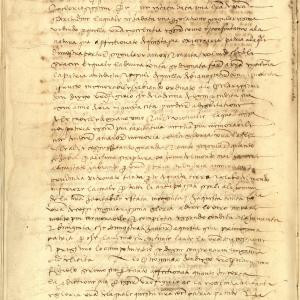The Genoa State Archive was established in 1817 in the new headquarters of the former “Criminal building” to preserve government archives. Since 2004, it has its headquarters in the monumental complex of S. Ignazio, on the hill of Carignano. The original unit of the complex is the sixteenth-century villa belonged to the De Franceschi family, with frescoes by the Semino brothers. Around the half of the seventeenth century the Jesuits purchased it.
This led it to a significant expansion, through the creation of spaces dedicated to the novitiate, and through the construction of the church of S. Ignazio on a project by the Ricca brothers, between 1723 and 1724.
The institute keeps the central and peripheral bodies acts of the Republic of Genoa (from the half of the 10th century to the annexation to the French Empire) and the peripheral bodies acts of the Kingdom of Sardinia, the Kingdom of Italy and the Italian Republic based in the province of Genoa. Thanks to the commercial expansion of Genoa in the Middle Ages, among the preserved government documents are treaties of alliance and economic agreements with the governments of the whole world known at that time, without prejudice of race and religion: Crusader kingdoms of the Holy Land, Byzantine Empire, Armenian Kingdom of Cilicia, Turkish and Tartar kings, sultans of Egypt and lords of Africa, Muslims of Spain, the Mighty of Italy and Europe. These documents, together with the ambassadors correspondence, allow us to study the foreign policy of the Republic of Genoa from the 11th to the 18th century.
The State Archive of Genoa also preserves the notarial archives, which still represent the most celebrated collection, universally known for its antiquity and for the number of medieval minutes: the 12th cartularies the only one of its kind in the world; the more than 150 cartularies of the thirteenth century as result of the approximately 50 registers kept in the rest of Italy and Europe; the almost 450 units of the fourteenth century and the 1033 fifteenth century files. The deeds stipulated by notaries testify to every aspect of the social, political, cultural and economic life of the Republic of Genoa and the Genoese overseas settlements. They also represent an unparalleled historical source for the breadth of the geographical horizon, from England to Flanders, from Spain to the Maghreb, from the Levant to the Black Sea.The Archive of the “Casa di San Giorgio” is also of great importance, the institution born in 1407 from the reorganization of the Genoese public debt, which up to 1805 also carried out a public banking activity of deposit and transfer, to which it added the concession of short-term credits in favor of the State and tax contractors, taking over the government in the overseas colonies, on the Corsica island and in numerous mainland districts. These archives represent, despite the inevitable gaps caused by time, a unique heritage for the study of political events, commercial activity and the evolution of society throughout the known world in the Middle Ages and in the modern age. To these are added the cartographic documentation and that from the offices and state bodies of the 19th and 20th centuries.





